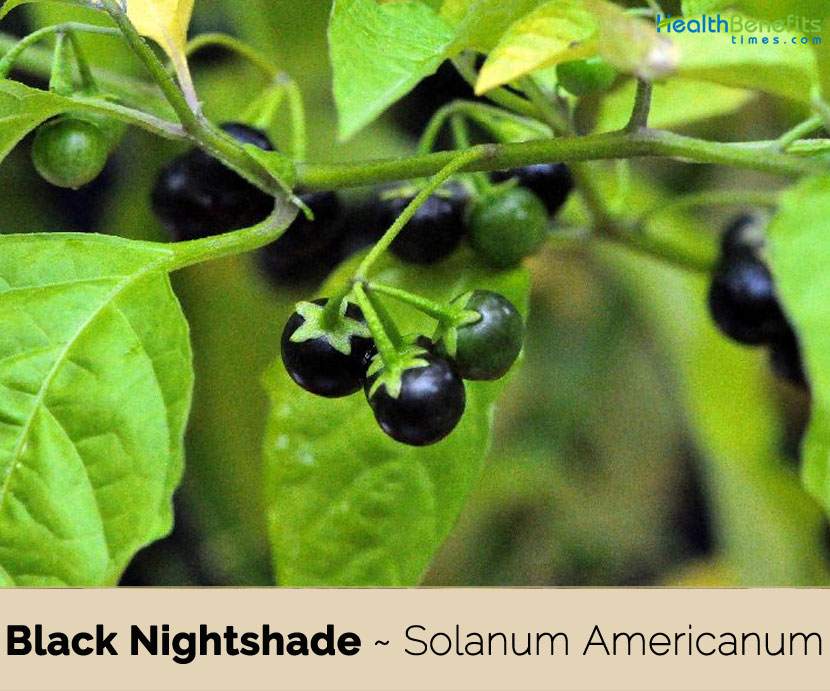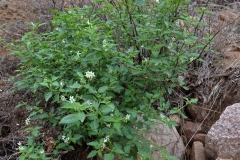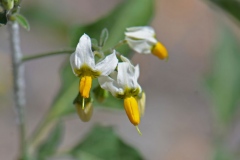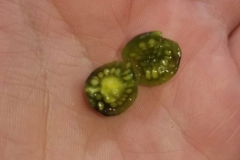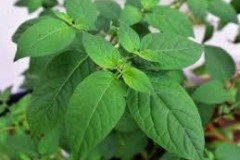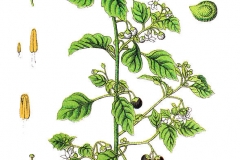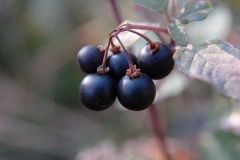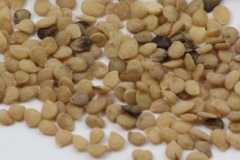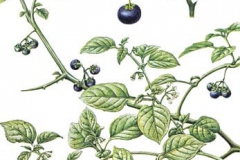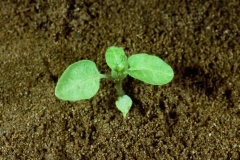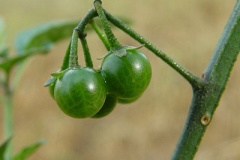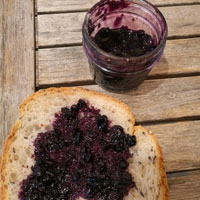| Black Nightshade Quick Facts | |
|---|---|
| Name: | Black Nightshade |
| Scientific Name: | Solanum Americanum |
| Origin | Around the Tropical Pacific and Indian Oceans, including Hawaii, Indochina, Madagascar and Africa |
| Colors | Green at early stage and turn to orange or black when ripened |
| Shapes | Globose berry 8–10 mm in diameter, from green turning to glossy purplish black at maturity, rarely dark green, many-seeded |
| Taste | Bitter |
| Health benefits | Prevention of Cancer, Prevents Jaundice, Cures Appetite and Feel of Distastes, Prevention to Hypertension, Helps Digestion, Cure Fever, Relieve Back Pain, Prevent scurvy, Cures Ulcer, Help to cure herpes, Improve Liver Function, Soothes Sore Throat, Works Natural Laxative Agent, Stimulates Kidney Function, Cures Skin Diseases, Helps Good Sleep, Cures Spleen Diseases, For Dry Eyes, As Men Contraception, Cyto-protective |
| Name | Black Nightshade |
|---|---|
| Scientific Name | Solanum Americanum |
| Native | Around the Tropical Pacific and Indian Oceans, including Hawaiʻi, Indochina, Madagascar and Africa |
| Common Names | Glossy nightshade, American black nightshade, Black nightshade, Large-fruited black nightshade, American nightshade, small-flowered nightshade, Common purple nightshade, Glossy nightshade, Smallflower nightshade, White nightshade, Apple of Sodom, common nightshade, Popolo-kikania, Black berried nightshade, garden nightshade, hound’s berry, Petty morel, Poison berry |
| Name in Other Languages | Arabic: ‘Enab edh dhi’b, ‘Enab eth tha’lab, Ribriq Assamese: Koisi,Laskosi Azerbaijani: Amerika quşüzümü Chinese: Shao hua long kui, Long kui Czech: Lilek americký Danish: Storfrugtet natskygge Dutch: Zwarte nachtschade English: Glossy nightshade, American black nightshade, Black nightshade, Large-fruited black nightshade, American nightshade, small-flowered nightshade, Common purple nightshade, Glossy nightshade, Smallflower nightshade, White nightshade, Apple of Sodom, common nightshade, Popolo-kikania, Black berried nightshade, garden nightshade, hound’s berry, Petty morel, Poison berry Fijian: Boro, malahome, mboro, mboro laukana, mboro ni veiwere, mboro ni yaloka ni ngata, mburosousou ni vavalangi, thevuthevu Finnish: Mustakoiso French: Herbe à calalou, morelle noire, Morelle d’Amérique, brède morelle, Morelle commune, Morelle des jardins, Morelle à fruits noirs German: Schwarzer Nachtschatten, Nachtkraut, Wolfstraube Hawaiian: Olohua, pōpolo, pōpolohua, polopolo Hindi: Mokoi (मोकोय) Hungarian: Kisvirágú csucsor Indonesia: Leunca, ranti, kampai Irula: Kakkae dagu Italian: Morella, Solano nero, Solatro del frutto nero, Solatro ortense Japanese: Inuhozuki (イヌホオズキ), Teriminoinuhoozuki (テリミノイヌホオズキ), amerika-inuhôzuki (アメリカイヌホオズキ) Laotian: Kh’èèngz namz Malay: Terong meranti, Terong perat, Kampai (Indonesia), Ranti Malayalam: Tudavalam, Karimthakkali, Anakurunthothi, Manithakkali, Manathakkali, Eradakukkeera, Mullakuthakkali Malaysia: Ranti, terong meranti, terong perat Maori (Cook Islands): Poro, poro puaka, poroporo Marathi: Laghukavali Marquesan: Oupoo Niuean: Polo, polo fua, polo kai Norway: Adventivstvier Papua New Guinea: Karakap Philippines: Anti, bolagtab, kuti Portuguese: Erva-moira, maria-pretinha Quechua: Qhaya-qhaya Russian: Paslon chornyy amerikanskiy (паслён чёрный американский) Samoan: Māgalo, polo Slovakian: Ľuľok čierny Spanish: Hierba mora, hierba mora negra, metagallina Sundanese: Leunca biasa, Leunca badak, Leunca manuk Swedish: Amerikansk nattskatta Tagalog: Anti, Kanti, Lubi lubi Tahitian: Oporo Tamil: Sirungunni, Milaguthakkali, Manathakali, Kaasithazhai, Manatakkali (மணதக்காளி) Telegu: Kasaka Thai: Ma waeng nok (มะแว้งนก), Ya tomtok Turkish: Itüzümü, Köpek memesi, Köpek üzümü, Tilki üzümü. Tongan: Polo, polo kai Urdu: Makoya (मकोया) Vietnamese: Hôt mít, Lù lù duc, Thu lù duc Visayan: Kuti, Bolagtab, Hulablub Wallisian: Polo |
| Plant Growth Habit | Annual or short-lived perennial herb, erect and widely spreading |
| Growing Climates | Common among rocks, along sand beaches, trails, in woodlands and fields, coastal to wet forest, subalpine woodland, disturbed roadsides, pasture, clearings, gardens, cane fields, plantations, on open gravel banks, waste land, thickets, shores or openings, Wet places, along margins of puddles, ditches, degraded moist deciduous forest areas and riversides, also in the plains |
| Plant Size | Up to 1–1.5 meters (39–59 in) tall |
| Stem | Stem rounded or narrowly winged, sometimes warty, glabrous or sparsely pubescent, young stem sometimes covered with curved, simple hairs |
| Leaf | Leaves are alternate on the branch, and vary greatly in size, up to 10 centimeters (3.9 in) long and 7 centimeters (2.8 in) broad, with a 4-centimetre (1.6 in) petiole and a coarsely wavy or toothed margin |
| Flowering season | October – April |
| Flower | Bisexual, nodding; calyx is campanulate, 1-3 mm long, 5-lobed, reflexed in fruit. Corolla is deeply 5-stellate, 8-9 mm in diameter, with yellow-green star, lobes oblong, and 1.5 mm wide, reflexed, white or purplish |
| Fruit Shape & Size | Globose berry 8–10 mm in diameter, from green turning to glossy purplish black at maturity, rarely dark green, many-seeded |
| Fruit Color | Green at early stage and turn to orange or black when ripened |
| Seed | Green at early stage and turn to orange or black when ripened |
| Propagation | By seed |
| Taste | Bitter |
| Plant Parts Used | Whole plant, leaves, stem |
| Season | November – June |
| Health Benefits |
|
Leaves
The leaves are arranged spirally and alternate on the branch, and vary greatly in size, up to 10 centimeters (3.9 in) long and 7 centimeters (2.8 in) broad, with a petiole about 4-9 cm long and a coarsely wavy or toothed margin. Leaf-blade is ovate to ovate-lanceolate and entire or sinuately lobed, base truncate to cuneate and decurrent along the petiole, apex acuminate.
Flower
Inflorescence is an umbellate cyme with 4-20 flowers, mostly supra-axillary; peduncle is slender up to 2.5 -5 cm long. Pedicel is 8-20 mm long and nodding. Flowers are bisexual, nodding; calyx is campanulate, 1-3 mm long, 5-lobed, reflexed in fruit. Corolla is deeply 5-stellate, 8-9 mm in diameter, with yellow-green star, lobes oblong, and 1.5 mm wide, reflexed, white or purplish. Stamens 5, inserted on corolla throat; filaments 1-2 mm long, often hairy on inner side; anthers are 1.5-2 mm long, yellow, opening by terminal pores. Ovary is globular, 1 mm in diameter; style 2.5-4 mm long, spreading hairy in lower half. Stigma is capitate, at about the level of the anther tips, pale green. Flowering normally takes place from October to April.
Fruits
Fertile flowers are followed by shiny, globular berry, 5–10 millimeters (0.20–0.39 in) diameter containing numerous small seeds. Fruits are initially green turning glossy bluish-black or purplish-black at maturity, readily shed when ripe. Flesh with 0-4(-8) sclerotic granules and about 40-100 seeds. Seeds are discoid, 1.5–2 mm long, creamy colored, often tinged with purple.
Health benefits of Black Nightshade
Listed below are some of the popular health benefits of using Black Nightshade
1. Prevention of Cancer
Cancer is considered as one of the scariest disease for many people. Sometime, it took long time to free from cancer. Black nightshade is one of the best prevention of cancer because this black nightshade consists of solasonine, solasodine, solamargine, and solanine that prevents uncontrollable cancer cell. Solasodine plays role to relieve pain, to decrease your temperature, anti-inflammation, and anti-shock. Solamargine and solanine as antibacteria, and solanine as anti-mitosis. Those substances handle various types of cancer such as breast cancer, cervix, stomach, and respiratory tract cancer.
2. Prevents Jaundice
Black Nightshade is a best preventive medicine for jaundice. Since it strengthens the liver muscles chances of getting jaundice is very less. People suffering from jaundice can make their diet with Solanum and can vanish the disease condition. Extract prepared from leaves and fruits of black nightshade are used to cure jaundice and liver diseases.
3. Cures Appetite and Feel of Distastes
We can prepare homemade medicines using black nightshade for cold also. It cures the loss of appetite and feel of distastes.
4. Prevention to Hypertension
If you have high blood pressure risk, then it is recommended for you to consume black nightshade regularly. It is not only a fresh vegetable, but also benefits to prevent hypertension and high blood pressure.
5. Helps Digestion
Black nightshade supplies all the required nutrients for the body. If it is included daily in the diet it helps to digest the food easily.
6. Cure Fever
Solanum consists of phosphorus, vitamin A, C and Vit B, iron, calcium and other micronutrients. People suffering from body heat can eat the cooked black nightshade leaves to calm their body heat and best remedy for skin allergies too. Extract of Solanum can cure the fever and body pain and joint pain caused by the fever.
7. Relieve Back Pain
Black nightshade is quite beneficial to relieve back pain, sore, muscle pain, stiff waist and gout. And also for those who suffer from rheumatism, black nightshade is also useful to cure rheumatism and all the symptoms. Nigeria has used black nightshade as an herbal to cure rheumatism and also uric acid.
8. Prevent scurvy
Scurvy is a disorder in mouth because of fewer vitamins C. Consuming Solanum Nigrum can prevent scurvy because it consists of good amount of vitamin C that is beneficial as scurvy preventive medicine. Besides that, consuming Solanum Nigrum can help body to solve many problems of infections mouth.
9. Cures Ulcer
It is also the best medicine for mouth ulcer. People suffering from mouth ulcer can take it as a regular diet and it will heal the stomach ulcer also.
10. Help to cure herpes
If you get herpes, you can try Solanum Nigrum as traditional medicine to solve your herpes. Substance content in Solanum Nigrum is supposed that can prevent herpes ant its symptom.
11. Improve Liver Function
Black nightshade helps to improve liver function so that it is beneficial to neutralize and release toxins inside your body.
12. Soothes Sore Throat
It helps to soothe a sore throat; the public speakers as well as the singers should include this in their diet.
13. Works Natural Laxative Agent
ညBlack nightshade is rich in fiber content and it acts as a natural laxative agent to prevent constipation problem.
14. Stimulates Kidney Function
It is considered the best herb to stimulate kidney function and it helps the filter the urine from the kidney.
15. Cures Skin Diseases
Skin boils, allergy, heat boils, skin irritation can be cured by using the Solanum extract on the affected area. This green’s paste can act as an external medicine and can be applied to the skin for skin treatment.
16. Helps Good Sleep
Seeds of black nightshade fruits are air dried and powdered and mixed with milk and taken during the night, it aggravates good sleep and calms the body tiredness. Solanum Nigrum seeds are good if tuberculosis patients and diabetic people included daily their diet.
17. Cures Spleen Diseases
Black Nightshade is a medicine for spleen diseases also. Solanum Nigrum has an antibacterial activity and hence it kills the disease-causing bacteria in the body. It fights against the microorganism and tries to increase the immune response in the body. It supports the spleen muscles and soothes the stomach ulcers. It decreases the body heat all you need is black nightshade greens, cumin seeds, turmeric powder, gingelly oil and salt.
Heat the pan with gingelly oil add cumin seeds allow it to fry later add the greens and fry it till it is cook add a tumbler of water with little turmeric powder. Cook it and include this in your diet this will greatly add strength to the spleen, liver and heal the stomach ulcer.
18. For Dry Eyes
Although black nightshade is not a main menu, it is a supportive vegetable to cure dry eyes in the right portion by daily use. Dry eyes will be healthier if you eat black nightshade regularly. Thus, there are many health benefits of black nightshade.
19. As Men Contraception
Black nightshade is considered as a powerful natural contraception for men. Black nightshade will improve the production of sperm and male genital fertility.
20. Cyto-protective
Black nightshade is also useful as cytopotective that helps you to prevents and cure from kidney disease. It is also supported by the activity of anti ulserogenic which is linked to central nerve system, stomach and antineoplastic.
Traditional uses and benefits of Black Nightshade
- Leaf juice is used to treat eye complaints especially conjunctivitis in Tanzania.
- Pounded leaves are used to treat sores and related skin problems in Cameroon and Brazil.
- Fruits have been used to treat worms in poultry in Nigeria.
- Black Nightshade has been used to treat asthma in Hawaii.
- It has been used to treat dermatophytoses and protozoal infections in Guatemala.
- It has been used as a molluscicide and to treat gastrointestinal disorders in Puerto Rico.
- Cutaneous leishmaniasis has been treated in Brazil using Black Nightshade.
- Decoction of the leaves is used in a lotion for yaws and to alleviate neuralgic pains in several traditional medicines.
- Fruits have laxative and diuretic properties and the juice is applied against dropsy and to cure eye diseases of chickens.
- Berries are recommended as an aphrodisiac in West Java.
- Its leaf juice is effective in curing Mouth Ulcers and Fever.
- It helps in reducing earache.
- It is a good herbal remedy for Asthma and Bronchitis.
- It combats stomach problems like stomach cramps, flatulence, and stomach ache.
- Black Nightshade counters Cirrhosis of the Liver. It also protects Liver and fights against Jaundice.
- Decoction prepared from its leaves and stem is a good herbal cure for Diuresis.
- Hemorrhoid is effectively treated by Black Nightshade.
- Its leaf juice is beneficial to counter difficult menses.
- It helps in curing Rheumatic Pain and Gout.
- It is helpful in the treatment of measles.
- It also helps in relieving pain associated with heart.
- It acts a tonic for those who are dealing with anorexia.
- Black Nightshade is used for the treatment of chronic fever.
- Being anti-diarrheal in nature, it cures diarrhea and symptoms associated with it.
- It provides strength and energy to the body.
- Black Nightshade is used as a blood purifier.
- It aids in treating night blindness.
- It boosts immunity and fight against leucoderma.
- It is used in the treatment of leprosy.
- Black Nightshade fights against skin diseases such as itching or eczema.
- Being anti-inflammatory in nature, it reduces inflammation associated with arthritis and gout.
- It is useful for the treatment of Cancer.
- Its fruit has been used to control diabetes.
- Its juice is helpful for the treatment of ringworm.
- Its fruit is used as a cosmetic. Rubbing the seeds of its fruit on the cheeks helps remove freckles.
- Juice of black nightshade is occasionally used to treat fever and alleviate pain.
- In Northern India, the boiled extracts of its leaves and fruits are used to alleviate the discomfort caused by liver-related ailments, even in jaundice.
- Leaves of black nightshade plant strongly promote perspiration, when ingested in small amounts. They work to purge the bowels the next day.
- Juice of the herb or an ointment prepared from it is externally applied to cure certain skin problems and tumors.
- A decoction of the stalk, leaves, and roots of black nightshade is beneficial for wounds and cancerous sores.
- Its berries are poisonous, but boiling them is believed to destroy the toxic substances and make them safe to be used for preserves, jams, and pies.
- An infusion of the plant is used as an enema in infants suffering from abdominal upsets.
- Freshly prepared extract of the plant is effective in treating cirrhosis of the liver and also works as an antidote to poisoning by opium.
- Decoction of the root, mixed with lime juice and a pinch of salt, is drunk as a treatment for malaria.
- An infusion of the leaves and stems is used to improve kidney function.
- Juice extracted from the leaves is used to relieve chronic conjunctivitis and related inflammations.
- Pounded leaves are used to treat sores and other skin problems.
Ayurvedic health benefits of Black Nightshade
- Abdominal Diseases: Grind the whole plant. Dip 4 teaspoon powder in one liter water for 2 hours. Drink frequently.
For Children: Prepare an infusion of plant. Filter. Use lukewarm as enema. - Swelling: Take 5 to 6 Black Nightshade berries. Fry in Ghee. Take once a day.
- Fever : Prepare infusion of Black Nightshade plant. Drink frequently.
- Dysentery: Clean Black Nightshade plant. Soak in a jug of water. Drink it after every 2 hours.
- Gonorrhea: Take out the juice of Black Nightshade leaves. Have one teaspoon with lukewarm water thrice a day.
- Urinary Tract Infection: Have one teaspoon leaf juice of Black Nightshade with slightly warm water twice a day.
- Gum Diseases: Chew 4 to 5 cleaned Black Nightshade leaves daily.
- Bad Breath: Take 50 gram dried Black Nightshade berries. Soak in a jug of water. Swish with lukewarm twice a day.
- Heart Disease: Take 15 Black Nightshade shoots and leaves. Boil. Eat once a day.
- Indigestion: Take 15 to 20 Black Nightshade berries. Fry in Ghee. Eat with every meal for 15 days.
- Aphthous Ulcers: Take 10 gram Black Nightshade Leaves. Boil in one glass of water. Swish with lukewarm twice a day.
- Diuretic: Take Black Nightshade stem and leaves in equal quantity. Prepare a decoction. Have 2 teaspoons twice a day.
- Flatulence: Squeeze out the juice of Black Nightshade Leaves. Take one teaspoon twice a day.
- Peptic Ulcer: Have one teaspoon juice of Black Nightshade Leaves twice a day.
- Abdominal Diseases: Prepare an infusion of Black Nightshade. Take one teaspoon thrice a day.
- Burns: Grind Black Nightshade with little water to make a paste. Apply it on affected parts twice a day.
- Rheumatism: Make a poultice of Black Nightshade. Apply it on affected parts.
- Skin Diseases: Apply poultice of Black Nightshade on affected parts.
- Ringworm : Grind Black Nightshade Berries to make a paste. Apply it on the affected part for 20 minutes.
- Difficult Menses: Take 2 tablespoons juice of Black Nightshade Leaves 4 times a day during menses.
- Orchitis: Take Black Nightshade Leaves. Heat and apply it on affected parts twice a day.
- Cough: Take flowers and berries of Black Nightshade in equal quantity. Prepare a decoction. Have 2 tablespoons twice a day.
- Cold: Take one teaspoon decoction of flowers and berries of Black Nightshade twice a day.
- Liver Diseases: Take drops of fresh extract of Black Nightshade for 2-3 days. (Note: Large dosage can be poisonous.)
- Freckles: Rub the seeds of Black Nightshade on the skin to clear Freckles.
- Diabetes: Include the fruit of Black Nightshade in your daily diet.
- Skin Diseases: Rub the fruit juice of Black Nightshade on the affected area.
- Tumors: Prepare an ointment from the leaves of Black Nightshade and apply on the affected parts.
- Edema: Take One tablespoon powder of the dried Black Nightshade leaves with water twice a day.
- Spleen Enlargement: Take 2 teaspoons of Black Nightshade syrup twice a day.
- Stomach Problems: Drink the unrefined leaf juice of Black Nightshade once daily. You can also mix with any other juice.
- Earache: Take out the juice from the leaves of Black Nightshade. Use this juice as ear drops to get relief from pain in ears.
- Toothache: Boil Black Nightshade berries in water in one glass of water. Let it cool. Strain it and extract the juice of berries by grinding it. Gargle and rub the juice on the affected area, two times a day.
- Dipsia: Black Nightshade berries act as a tonic and provide relief from Dipsia. Consume Black Nightshade berries.
- Tuberculosis: Prepare a decoction, made of Black Nightshade leaves and one cup of water. Strain and drink it. It is helpful in treating Tuberculosis.
- Jaundice: Prepare a decoction of Black Nightshade leaves and berries in one cup of water. Strain and drink it. This decoction also aids Liver Diseases.
- Asthma: Boil Black Nightshade roots in one cup of water for 10 minutes. Strain and drink it. This remedy is useful against Asthma.
- Dysuria: Make a decoction of Black Nightshade leaves and stems in one cup of water. Strain and drink it. This decoction act as a Diuretic.
- Digestive Disorders: Prepare a decoction of Black Nightshade leaves in one cup of water. Strain and drink it.
- Arthritis: Take out the juice of Fresh Black Nightshade. Add equal amount of Sesame oil, Ginger powder and two tablespoons Mustard oil. Mix and Boil them. Apply on the affected part twice a day.
- Rheumatism: Mix equal quantity of Fresh Black Nightshade juice, Sesame oil, Ginger powder and two tablespoons of Mustard oil. Boil. Strain. Apply lukewarm on the affected part twice a day.
- Gum Diseases: Take equal amount of Black Nightshade leaves and Green Gram. Boil. Add salt according to the taste. Drink one cup daily.
- Aphthous Ulcers: Prepare an infusion of Black Nightshade berries. Use it as a mouth wash.
- Bad Breath: Take 10 to 15 Black Nightshade berries, one teaspoon crushed Garlic, 4 Cardamom and one tablespoon Fenugreek seeds. Roast; now boil in a jug of water. Swish with this lukewarm water twice a day.
- Cough: Fry a handful of Black Nightshade berries, 10 gram crushed Garlic, 4 Cardamom and one tablespoon Fenugreek seeds. Boil in one liter water. Gargle with this lukewarm water twice a day.
- Jaundice: Take a handful of dried Black Nightshade berries, 30 grams Crushed Cumin and 30 grams crushed Coriander seeds. Soak them in a jug of water together overnight. Have one cup twice a day.
- Hepatitis: Soak, 5 dried Black Nightshade berries, one teaspoon Crushed Cumin and one teaspoon crushed Coriander seeds in two cups of water, overnight. Take one cup twice a day.
Culinary Uses
- Leaves and young shoots are boiled and used as a leafy vegetable.
- Fruit should be used only when fully ripe.
- They are used in pies, jams and other sweets in Philippines.
- In India, black nightshade berries are grown and eaten by local people. The dish is more common in Northern Tamil Nadu, Southern Andhra and Southern Karnataka. However, the plant is not cultivated for commercial purposes.
- In Ethiopia, ripe fruits of black nightshade are eaten by children during normal times, while all the affected people eat fruits of the plant during famines. The leaves are also collected by women and cooked in salt water. They are then consumed like any other vegetable.
- It is known that farmers in the Konso Special Woreda use it as source of food, until their maize crops are ready for harvesting, since the plant matures before maize. The Welayta people of the adjacent Semien Omo Zone do not remove this weed appearing in their gardens. Instead, they cook and eat the leaves of the plant.
Black Nightshade Jam Recipe
Ingredients
- 500 g of fresh ripe Black Nightshade berries
- 400 g of quality raw sugar
- 1 tbsp. of lemon juice
Directions
- Remove the berries from the stems with your hands or isolate the berries while you forage them. Remove any bits of leaf and stalk.
- Gently wash the berries with fresh water. Careful because these berries are porous.
- Place the berries in a heavy-based pan and gently crush with a potato masher or squeeze with your hand, just enough to release some of the juices. Turn the pan on.
- Add the sugar and lemon juice to the pan and leave to simmer on low heat. Allow for 5 minutes of bubbles. Keep stirring to prevent the jam sticking to the bottom of the pan.
- Cook down for around 20 minutes. Allow about 5 minutes of bubbles to come while simmering
- Put the jam into clean jars. The jam will keep in a cool dark place for 1 year. Once opened keep in the fridge.
Precautions
- Green fruit is particularly poisonous and eating unripe berries has caused the death of children.
- Ripe berries and foliage may also cause poisoning, though the toxicity seems to diminish somewhat with ripening.
- Livestock can also be poisoned by high nitrate levels in the leaves.
- It is quite poisonous and if taken in higher dose.
- It may cause Nausea, Headache, Diarrhea and Dizziness.
References:
https://www.itis.gov/servlet/SingleRpt/SingleRpt?search_topic=TSN&search_value=565523#null
http://www.hear.org/pier/species/solanum_americanum.htm
https://npgsweb.ars-grin.gov/gringlobal/taxonomydetail.aspx?id=100795
https://pfaf.org/user/Plant.aspx?LatinName=Solanum+americanum
https://www.cabi.org/isc/datasheet/117222
https://plants.usda.gov/core/profile?symbol=SOAM
https://en.wikipedia.org/wiki/Solanum_americanum
http://www.narc.gov.jo/gringlobal/taxonomydetail.aspx?id=100795
http://www.theplantlist.org/tpl1.1/record/tro-29600095
https://indiabiodiversity.org/species/show/245037
https://gd.eppo.int/taxon/SOLAM
http://www.flowersofindia.net/catalog/slides/Black%20Nightshade.html
https://prota4u.org/database/protav8.asp?g=pe&p=Solanum+americanum+Mill.


